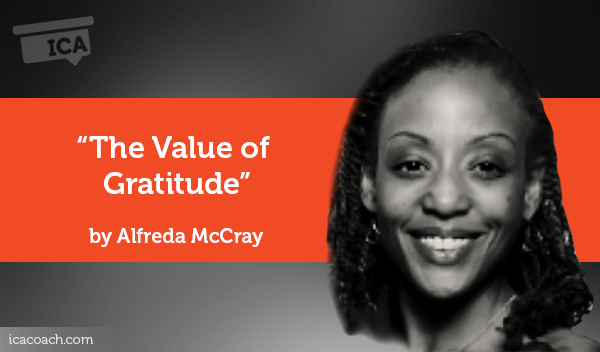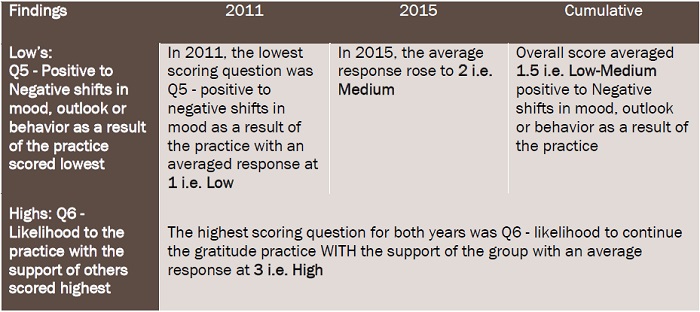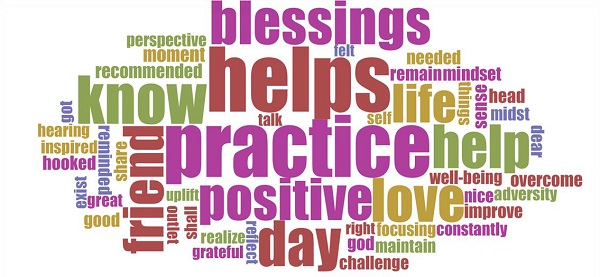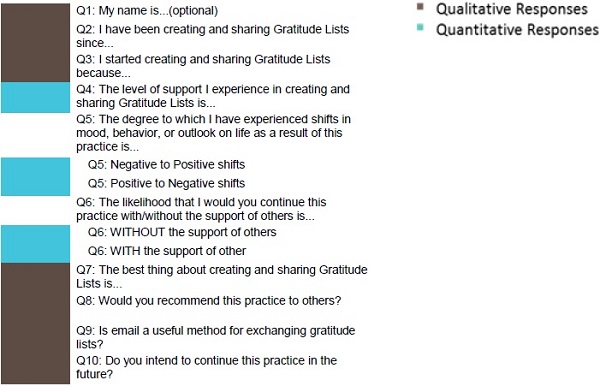 Research Paper By Alfreda McCray
Research Paper By Alfreda McCray
(Life Coach, UNITED STATES)
Sharing Gratitude: Perspective Shifter, Mood Lifter, Connection Builder
Abstract
This paper provides the results of a longitudinal study conducted to collect thoughts, sentiments, and experiences from among a small group of individuals committed to creating and sharing a daily gratitude practice. This practice consists of creating and emailing ten things to be grateful for each day to the individuals in the group. The findings in the study are based upon survey data taken from the years 2011 and 2015 respectively.
Qualitative responses were analyzed using text analysis and data visualization tools1. The results are in the form of word collage images generated using word counts and frequency. Quantitative data shows the comparison of data points between years as well as the cumulative averages over time.
The findings are not conclusive nor intended to make any scientific claim, however they do provide insight from observation, personal account, and narrative into the experiences of participants who regularly create and share their gratitude practice. Lastly, coaching applications are discussed to explore opportunities for using gratitude practices in both a self-coaching and client-coach partnership.
Gratitude is recognizing and acknowledging the gifts we are given, either by other people, God, or by life itself (Neff, 2011, p. 277)
Dr. Kirsten Neff, author of the book Self Compassion, attributes the above definition to Richard Emmons, scholar and authority on the subject. For the purposes of this paper, it will serve as the working definition to describe the application of gratitude for the study.
About the practice
I was introduced to the practice of sharing gratitude lists by my very first coach in 2007. She conducted a group coaching workshop and as a part of the cohort, we created and shared our gratitudes or wins during and in between our coaching sessions. I was pretty much hooked after that.
In the summer of 2009, I had a conversation with a good friend about some of the challenges she faced in her grad school program; I suggested we share our gratitudes to stay motivated, focused, and uplifted. And that’s how it started—the spread of the gratitude practice. One friend shared with another and on it went, and magically keeps going. While there are admittedly lapses for weeks or sometimes months, someone in the group will start the emails back up again. And we all join in. There are no draconian requirements for participation. You set the intention and join in when you can. And, this has been an eight-year practice which I continue, advocate for, and even swear by. It has helped me savor life in a much more intentional and energetic way. When I need a perspective shift, I turn to this practice, and the support from the group has been priceless.
1 Voyant Tools is a web-based reading and analysis environment for digital texts
About the survey
The idea of creating a survey to collect feedback did not start with a pre-supposition, but rather simple curiosity. As some gratitude list participants did not know each other personally, there was a central concern around levels comfort and engagement. A simple 10-question survey was put together to understand the factors that kept the individuals engaged in the practice. The survey was administered twice at two separate periods once in 2011 and again 2015. The survey contains both open-ended qualitative and quantitative response questions. The contents of the questions are as follows:
About the responses
The quantitative responses are provided below followed by the qualitative or open-text answers.
Quantitative responses
The quantitative responses derive from Questions 4, 5, and 6: Q4—captures the level of support experienced in creating and sharing Gratitude Lists, Q5—captures two responses for sentiments around shifts in mood, behavior, and outlook as a result of the practice, and Q6—captures the likelihood of continuing the practice with or without the support of the group. Options for responses were offered using a high, medium, low scale. The results were translated to a numerical scale: 1=Low, 2=Medium, and 3=High to calculate averages.
The chart below illustrates averaged responses for 2011, 2015, and cumulative totals for both years. The findings table provides notable insights gathered from high and low responses.

 Qualitative responses
Qualitative responses
The qualitative or open-text responses derive from Questions 3 and 7: Q3—I started creating and sharing Gratitude Lists because… and Q7—The best thing about creating and sharing Gratitude Lists is… The open-text responses from 2011 and 2015 were aggregated then compiled using a visual text analyzer, creating a word collage that depicts word usage and frequency. The table below depicts the results for each data set analyzed:
Coaching Applications
This section describes examples of coaching applications using a gratitude practice.
If gratitude is so essential to life satisfaction then part of our role as coaches is to encourage our clients to be more grateful.– International Coach Academy
As coaches there are lots of opportunities to facilitate gratitude to contribute to life satisfaction. 2 The survey results showed that having support from the group was a key contributor in continuing the gratitude practice. Coaches play key roles in supporting and helping our clients develop practices and implement tools that contribute to their well-being. Creating a gratitude practice can be one of those tools, as either a self-management tool used solely by the client, or in partnership with the coach to deepen or develop trust and connection with the client. The content of gratitude lists provides extremely valuable information to the coach and coaching client. It is clear, direct, first-hand insight into the client’s perspective, use of language, and values. Over time, those factors can reveal trends or themes that aid the coaching relationship. And, by inviting curiosity into the gratitude practice, we can generate powerful questions and/or design actions based upon what the client has shared. Using the individual self-management model as an example, a client could use a gratitude practice to develop self-awareness around the factors that truly build a sense of enthusiasm, peace, joy, and appreciation.
2 Source: International Coach Academy, Module on Gratitude:
Summary
Gratitude has notable reciprocal qualities, opening the channels to give thanks appear to be the same channels to receive abundance, an intangible and perhaps immeasurable outcome from the survey, but nonetheless felt when reading over the open-text responses. What I learned about the practice of shared gratitude is that like meditation, it is a practice—one you can keep coming back to even in lapses of silence. It keeps us engaged and connected. It brightens us as we share and connect on a deep and meaningful level. There is currently a significant volume of scientific research that suggests that gratitude improves subjective well-being3. This study was based upon personal experiences from individuals actively participating in and sharing gratitude at a practical level both in their own lives and with one another. As a I look over the qualitative responses for Question 7— “The best thing about creating and sharing Gratitude Lists is…,” a phrase stands out to me, “reading life, taking time,” and effectively that is what this practice helps us to do. Take the time to reflect upon the great things, the small things, the mundane things and find appreciation in all of the things happening in all of our lives every day.
Gratitude is contagious, once you receive it, you have to give it away.
3 See UC Berkeley Greater Good Science Center resources on gratitude http://greatergood.berkeley.edu/expandinggratitude



